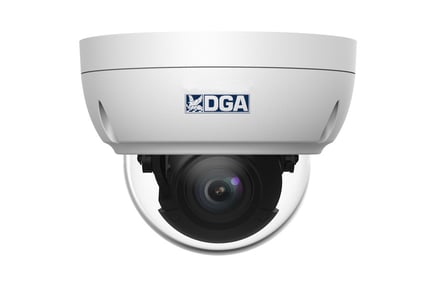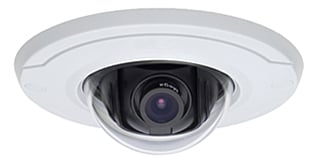Why Should I Invest in a Professionally Installed Security Camera System?
John Kolb is Director of Technical Sales at DGA Security, where he provides advanced technical support to DGA customers and evaluates emerging security technologies. A 43-year industry veteran, John holds a Certified Engineering Technologist (CET) status from NICET and a Certified Protection Professional (CPP) status from ASIS International, the gold standard certification for security management professionals.
If you’re shopping for business security cameras, you might wonder why anyone would bother paying for a professionally installed commercial security camera system at all when you could just do-it-yourself (DIY).
DIY security cameras do have value, but with that price reduction, you’ll also get a reduction in overall security. DIY cameras lack many of the features that professionally installed security cameras have, like 24/7 monitoring, HD video resolution, integration into your intrusion alarm or access control system, and an independent power source.
If you’re not convinced yet, let’s review what makes a professionally installed business security camera system the better choice, starting with a review of the different parts that make up a security camera system.
If you ever get confused by all of the terms and acronyms, head to the end of this post for a helpful glossary.
The Anatomy of a Security Camera System
Security camera systems include cameras, wiring, servers, and, optionally, video monitors. Additionally, software is an important part of many security camera systems which allows for integration with other products and mobile/web access to video services.
In a wired security system, each camera is connected to a cable or wire which leads back to the server. If you want, you can use a remotely mounted switch that will connect several cameras with one wire.
On the subject of wiring, we always recommend wired cameras and wired security devices in general. Wireless devices have gotten better over the past few years but are still nowhere near as reliable as wired devices. Wireless signals are easily interfered with (even furniture in the wrong location could impede a signal) and need either a power cord or batteries, which need frequent replacement and represent a potential point of failure.
Once the video is sent to the server or recorder, it is first processed and stored locally and critical data is transmitted to the cloud, where it can be integrated with other parts of your business security system, like your access control and intrusion alarm detection systems. In other words, these cameras can be used intelligently in conjunction with motion sensors, door contacts, access readers, and other security devices. For example, you could set up your system so that if an intrusion alarm went off, the camera nearest to the event would automatically enhance the recording rate and then send that video to your monitoring center allowing them to quickly take appropriate action.
Types of Cameras
As for the cameras themselves, you have many options as to price, appearance, and capability.
Our favorite type of camera is the dome camera, which works well in many situations.
Dome cameras generally work well indoors and out because the plastic lens dome keeps the camera safe from grime and dust. Unlike other camera types, the use of a darkened dome can make it difficult to see where a camera is pointed - great for deterring criminals who might want to walk in the camera’s blind spot.
Dome cameras typically have very wide-angle fields of view, which means you can see more of a scene at once. If you need to see a certain section in more detail, you can digitally zoom in.
There are three kinds of dome cameras: standard, mini, and recessed.

Standard is the largest dome and usually has a varifocal lens, which allows you to adjust your field of view from wide for a general view to narrow (also known as telephoto) for a tight, detailed view. The high-resolution and varifocal capabilities make this the most versatile type of dome camera.

Mini dome cameras are the smaller cousins of standard domes and often lack varifocal lenses. These tend to be popular among customers with high aesthetic standards because they don’t attract too much attention.

Recessed dome cameras are not only small but are effectively recessed into the ceiling to minimize appearance. They are even more popular than mini-dome cameras and are requested in many high-end stores. However, these cameras can be difficult to install since you need 6 inches of vertical ceiling space and 3 inches of horizontal ceiling space to mount the cameras.
In addition to dome cameras, you sometimes see bullet cameras, though they are becoming rarer. They do not offer any real benefits over a dome camera and are big and bulky. They are more easily damaged and criminals can easily see what direction the camera is pointing in.
Lastly, Facial Height Surveillance cameras are a custom-designed model from DGA. These cameras are mounted at face height with high-resolution sensors so that faces can be clearly captured. This is ideal for offices and retail stores. One advantage of this camera is that criminals cannot effectively conceal their faces with a hat as they could with ceiling-mounted cameras.
This isn’t a list of every type of camera out there, nor is it even every type of camera we install, but these are the most common cameras you will encounter.
Which camera is right for me and my business?
- In short, the type of camera you should purchase depends on your specific needs.
If aesthetics are the most important thing to your business, go with a recessed or mini dome camera. - If your business is in high-value goods, you may want to install facial height cameras at entrances.
- For general security indoors and out, a standard dome camera is your best bet, but there are no hard and fast rules, and only a video systems professional will be able to advise the best possible camera for your specific needs.
So why invest in a professionally installed security camera?
Unfortunately, professionally installed security products (as opposed to their do-it-yourself counterparts) aren’t cheap. And now that you know the best types of cameras for your business needs, you might be tempted to install them yourself, but there are a few things you should keep in mind first.
One of the biggest differences with a professionally installed video security system is that a real person will monitor your system when an alarm is tripped and can quickly deploy an officer if the video shows suspicious activity.
We’ve heard cases where business owners with DIY (do-it-yourself) cameras found out for the first time their cameras weren’t working after a crime already occurred, resulting in nothing to hand over to the police.
In terms of storage, DIY cameras tend to store video on the device itself. If a criminal decided to steal or damage the camera, then all the video would be lost. With a business security camera system, video is sent to a server so that even if a thief does damage a camera, the video record remains intact.
DIY cameras might offer great prices but are ultimately less reliable. With a professionally installed system, there are multiple points of failure, meaning that your security will remain intact even if one part of the system fails, giving you more time to react and restore full functionality.
DIY cameras have their place in low-risk situations, but if your business contains high-value goods or data, we will always recommend a professionally installed security camera system.
Got questions about business security cameras? We’ve got answers.
DGA has been specializing in commercial security and fire systems for more than 50 years. Call us for a free consultation at 800-PICK-DGA (800-742-5342) or submit a request online.
Glossary
- Digital Zoom – Selectively enlarging an area of a digital image using software.
- Fixed lens – A wide-angle lens that cannot have the position adjusted.
- Integration – Interactivity with other parts of a security system - e.g. integration between an access control system and a security camera system.
- IP – Internet Protocol. The technology used for sending data over the Internet.
- IR – Infrared technology allows cameras to capture grainy black and white images even when it is dark.
- IVS – Integrated Video Server. Processes video locally and transmits critical data to the cloud.
- Narrow-angle – Narrower field of view with high resolution.
- Resolution – The number of pixels on a display. The more pixels, the clearer and sharper the image. 4K resolution is typical for newer security cameras.
- Telephoto – The type of lens used to create a narrow view.
- Varifocal lens – A lens that can be adjusted for a field of view from wide (for general view) to narrow (for task view).
- Wide-angle lens – Wider field of view with lower resolution. This is more common.
- Wide Dynamic Range – Light Balancing. If one corner of an image is light and another dark, this technology will automatically balance out the brightness so that nothing is over or underexposed.
Related Articles
Common Video Surveillance Mistakes to Avoid
Benefits of Integrating Video Surveillance & Access Control Systems
Should your business security systems provider have a SOC audit?



